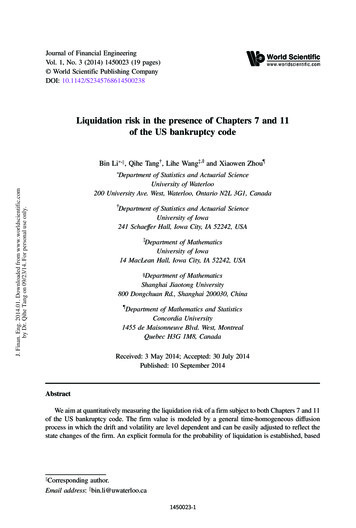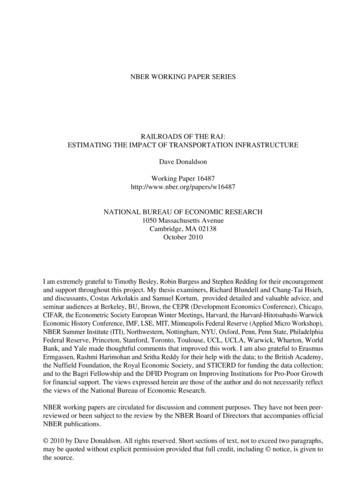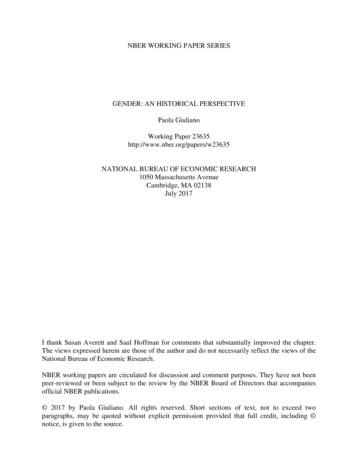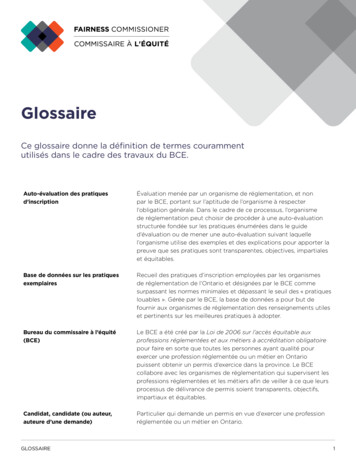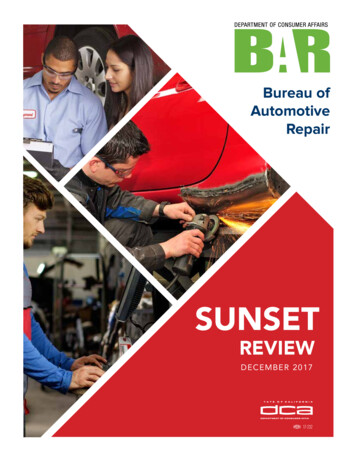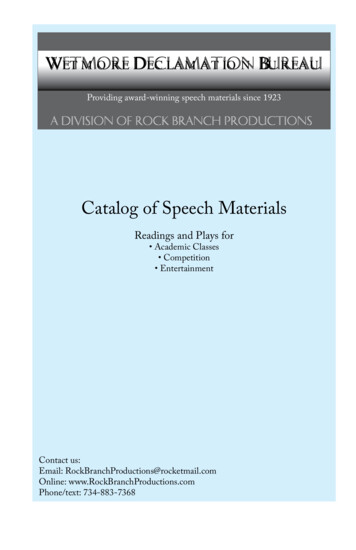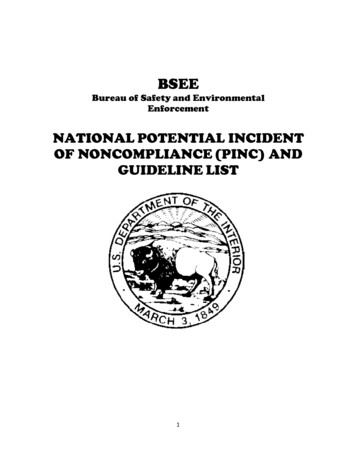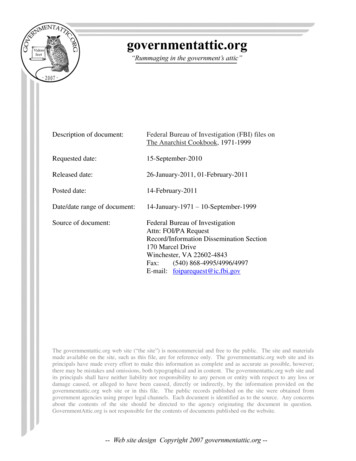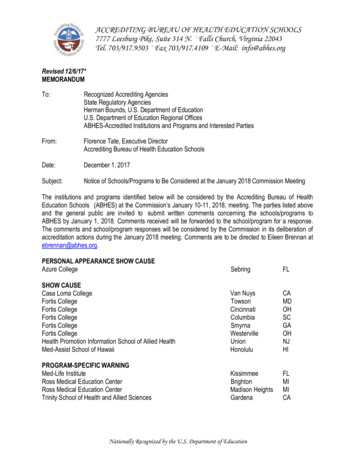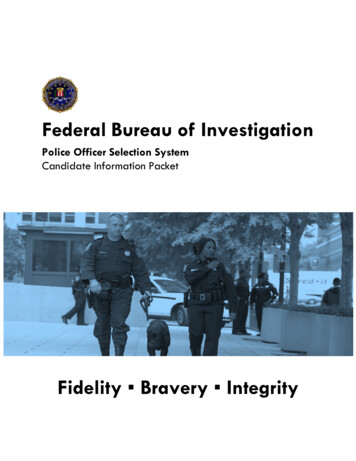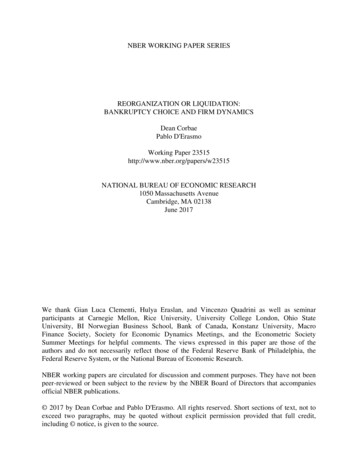
Transcription
NBER WORKING PAPER SERIESREORGANIZATION OR LIQUIDATION:BANKRUPTCY CHOICE AND FIRM DYNAMICSDean CorbaePablo D'ErasmoWorking Paper 23515http://www.nber.org/papers/w23515NATIONAL BUREAU OF ECONOMIC RESEARCH1050 Massachusetts AvenueCambridge, MA 02138June 2017We thank Gian Luca Clementi, Hulya Eraslan, and Vincenzo Quadrini as well as seminarparticipants at Carnegie Mellon, Rice University, University College London, Ohio StateUniversity, BI Norwegian Business School, Bank of Canada, Konstanz University, MacroFinance Society, Society for Economic Dynamics Meetings, and the Econometric SocietySummer Meetings for helpful comments. The views expressed in this paper are those of theauthors and do not necessarily reflect those of the Federal Reserve Bank of Philadelphia, theFederal Reserve System, or the National Bureau of Economic Research.NBER working papers are circulated for discussion and comment purposes. They have not beenpeer-reviewed or been subject to the review by the NBER Board of Directors that accompaniesofficial NBER publications. 2017 by Dean Corbae and Pablo D'Erasmo. All rights reserved. Short sections of text, not toexceed two paragraphs, may be quoted without explicit permission provided that full credit,including notice, is given to the source.
Reorganization or Liquidation: Bankruptcy Choice and Firm DynamicsDean Corbae and Pablo D'ErasmoNBER Working Paper No. 23515June 2017JEL No. E22,G32,G33ABSTRACTIn this paper, we ask how bankruptcy law affects the financial decisions of corporations and itsimplications for firm dynamics. According to current U.S. law, firms have two bankruptcyoptions: Chapter 7 liquidation and Chapter 11 reorganization. Using Compustat data, we firstdocument capital structure and investment decisions of non-bankrupt, Chapter 11, and Chapter 7firms. Using those data moments, we then estimate parameters of a firm dynamics model withendogenous entry and exit to include both bankruptcy options in a general equilibriumenvironment. Finally, we evaluate a bankruptcy policy change recommended by the AmericanBankruptcy Institute that amounts to a “fresh start” for bankrupt firms. We find that changes tothe law can have sizable consequences for borrowing costs and capital structure which viaselection affects productivity (allocative efficiency rises by 2.58%) and welfare (rises by 0.54%).Dean CorbaeDepartment of EconomicsUniversity of Wisconsin, Madison1180 Observatory DriveMadison, WI 53706and NBERcorbae@ssc.wisc.eduPablo D'ErasmoFederal Reserve Bank of PhiladelphiaResearch DepartmentTen Independence MallPhiladelphia PA 19106pabloderasmo@gmail.com
1IntroductionAccording to Aghion, Hart, and Moore [2] (p. 524), Western bankruptcy procedures “arethought either to cause the liquidation of healthy firms (as in Chapter 7 of the U.S. BankruptcyCode) or to be inefficient and biased toward reorganization under incumbent management (asin Chapter 11 in the United States).” Aghion, et. al. [2] go on to propose a bankruptcy policysimilar to a recent proposal by the American Bankruptcy Institute that amounts to a “freshstart” for the firm (existing debt is forgiven, and the new all-equity firm is allocated to formerclaim holders using the priority rule).1 To evaluate the implications of bankruptcy proceduresfor firm value, industry dynamics, and household welfare, we estimate a structural corporatefinance model with both Chapter 7 and Chapter 11 bankruptcy options using Compustat dataand then consider the above mentioned policy counterfactual.We find that the reform results in a considerable reduction of the bankruptcy rate (by51.1%) and a shift toward reorganization (away from inefficient liquidation) with a modestcontraction of the exit rate. There is a significant increase in the investment rate ( 19.1%)at the firm level due, in most part, to a large reduction in the fraction of firms that operatein the “inaction” region (i.e., firms operating with investment rates close to 0%). Prior tothe reform, incentives to hold capital as collateral are stronger and induce firms to operateat an inefficient scale. Better credit terms after the reform result in a change in the firmsize distribution (the average size of incumbent decreases, and the average size of the entrantincreases), reduce the fraction of firms with investment bursts (by more than 5%), improveallocative efficiency, and increase output weighted productivity by close to 0.5% (measuredtotal factor productivity (TFP) increases by a similar percentage). The combination of theseeffects results in a reduction in aggregate adjustment and bankruptcy costs that induce anincrease in aggregate consumption ( 0.54%).2Besides evaluating an important policy counterfactual, our paper makes two further contributions to the literature. First, using Compustat data from 1980 to 2014, we documentcapital structure and investment differences between non-bankrupt, Chapter 11 and Chapter7 firms.3 Our paper thus complements several studies that document heterogeneity amongfirms that choose Chapter 7 and Chapter 11 bankruptcy. One of the most recent papers is byBris, Welch, and Zhu [10] who provide a comprehensive study of the costs of Chapter 7 versusChapter 11 in a sample of 300 public and private firms in Arizona and New York from 1995to 2001. Reorganization by Chapter 11 comprises 80% of their sample. Chapter 11 firms are1A Chapter 7 bankruptcy policy that gives consumers a “fresh start” has been in practice since 1978. For ananalysis of the policy, see Livshits, MacGee and Tertilt [30] and Chatterjee, et. al. [12].2The idea that policies that affect the cost of exit can have important implications for entry, the firm sizedistribution, and welfare is not new. For instance, Hopenhayn and Rogerson [26] (see Table 3) find that firing costscan have a significant impact on hiring, the firm size distribution, and welfare.3We complement Compustat with information from the UCLA-LoPucki Bankruptcy Research Database.2
substantially larger in terms of assets, have a larger fraction of secured debt, and have roughlysimilar debt-to-asset ratios to Chapter 7 (see their Table 1). Importantly, their paper documents substantial differences in recovery rates. In particular, Table 13 documents the median(mean) recovery rate (as a percentage of the initial claim) as 5.8% (27.4%) for Chapter 7,while it is 79.2% (69.4%) for Chapter 11. Further, the fraction of firms that have 0% recoveryis 79% for Chapter 7 and 0% for Chapter 11. These means are similar to those by Acharya,Barath, and Srinivasan [1], who document (Table 8) that the mean recovery rate for Chapter7 is 26.38% and for Chapter 11 is 68.43%.4As Bris, et. al. [10] point out, whether a corporation files for Chapter 7 or 11 is endogenous,and self-selection can contaminate the estimation of bankruptcy costs. In particular, if firmsself-select, then it could be misleading to compare the cost of procedures without controllingfor endogeneity of chapter choice. The authors carefully attempt to control for self-selectioninto bankruptcy chapter (Chapter 7 or 11) in their regressions. Endogeneity issues lead usto consider a structural framework. Our second contribution is to extend the basic structuralcorporate finance models of Cooley and Quadrini [13], Gomes [20], and Hennessy and Whited[23] to incorporate a non-trivial bankruptcy choice.5,6,7 Adding a non-trivial bankruptcy choiceto an environment where cash flows can turn negative (due to fixed costs, as in Hopenhayn [24])has important implications beyond the selection issues raised above. For instance, it impliesthat liquidation arises in equilibrium for a subset of firms in our model, while it does not inCooley and Quadrini [13] or Hennessy and Whited [23]. It even shows up methodologicallysince, with liquidation costs that depend on the amount of collateral, here we must expandthe state space and cannot simply use net worth. Further, these papers only consider take-itor-leave-it bargaining in renegotiation.8Our paper proceeds as follows. In Section 2, we document bankruptcy facts in the Compustat dataset. In Section 3, we propose a general equilibrium environment with firm dynamicswhere there are Chapter 7 and Chapter 11 bankruptcy choices. Section 4 defines an equilibrium, and Section 5 estimates model parameters for that environment. Section 6 presentsequilibrium capital structure and investment decision rules in the presence of competitive debt4These values are themselves averages between no industry distress and industry distress states.In an important corporate finance paper, Broadie, Chernov, and Sundaresan [11] study Chapter 7 versus Chapter11 decision problem but in a much simpler model with exogenous cash flows and initial bond finance of fixedinvestment. Also related are Peri [35], who in a model with fixed capital, focuses on labor contract renegotiationsduring Chapter 11 reorganization, and Tamayo [40], who studies the effects of eliminating Chapter 11 reorganizationin a partial equilibrium model with private information where default can lead to liquidation or reorganization butdebt is constant over the life of the firm.6Other closely related papers that incorporate liquidation include Arellano, Bai and Zhang [6]; D’Erasmo andMoscoso Boedo [16]; Khan, Senga, and Thomas [28]; Meh and Terajima [32]; and Cooper and Ejarque [14].7Our paper also contributes to the literature on firm dynamics and misallocation pioneered by Restuccia andRogerson [36] and Hsieh and Klenow [27], with important contributions by Guner, Ventura, and Xu [21]; Midriganand Xu [31]; and Moll [33]. See Hopenhayn [25] for a recent review of the literature.8Eraslan [18] studies Chapter 11 in a more general bargaining environment.53
pricing, as well as Chapter 7 versus Chapter 11 event analyses. Section 7 evaluates the positiveand normative consequences of the policy counterfactual based on the “fresh start” proposalby the American Bankruptcy Institute. Section 8 concludes.2Bankruptcy Facts from CompustatGiven the fact that the vast majority of empirical corporate finance papers use data fromCompustat, we organize bankruptcy facts using Compustat data from 1980 to 2014. This isobviously a different sample than that in Bris, et. al. [10]. Some of our facts are similarto those in Bris, et. al. [10] (e.g., the fraction of Chapter 11 bankruptcies relative to thetotal number of bankruptcies), while other facts differ (firms are more highly levered in theirsample). We note, however, that there can be substantial differences in reported bankruptcyfacts across datasets. For instance, bankruptcy statistics on all business filings from the U.S.Courts aspx) suggest that the Bris, et. al.[10] sample as well as ours overstates the proportion of Chapter 11 business bankruptcies. Forinstance, in the U.S. Courts dataset (which includes smaller firms), the fraction of Chapter 11business bankruptcies out of total business bankruptcies was roughly 25% for the year endingin December 2013.Besides simply comparing characteristics of firms in the state of bankruptcy as in [10] or theU.S. Courts dataset, here we also compare characteristics of firms that are not bankrupt withthose that are bankrupt. Table 1 displays a summary of some key differences between Chapter7, Chapter 11, and non-bankrupt firm variables, which have analogues in our model (seeAppendix A1 for a detailed description of the data). Since there can be substantial differencesbetween the median and mean of these variables, the table provides both. In Figures 1 and 2,we graph the conditional distributions of some of the key variables in the model. Further, wetest whether the means differ between Chapter 7, Chapter 11, and non-bankrupt.We follow the classification of Chapter 7 and Chapter 11 bankruptcy used by Duffie, Saita,and Wang [17]. Chapter 7 in Table 1 corresponds to values for the final observation of a firmthat exits via a Chapter 7 bankruptcy. Chapter 11 refers to an observation in the initial periodof a Chapter 11 bankruptcy. Non-bankrupt identifies annual observations of firms that are notin the state of bankruptcy (i.e., firms that never declare bankruptcy) as well as observations offirms before they declare bankruptcy, excluding the above. To be consistent with the way thatthe U.S. Census Bureau constructs its exit statistics, a deleted firm (i.e., a firm that disappearsfrom our sample) is counted as a firm that exits if its deletion code is not 01 (mergers andacquisitions), 02 (bankruptcy which we associate with Chapter 11), 04 (reverse acquisition),09 (going private), or 07 and 10 (other). For example, this means that firms that are acquiredor go from public to private are not counted as exiting. Code 03 is defined as liquidation,4
which we associate with Chapter 7. In the Appendix, we provide more information about thefrequencies of those events.Table 1: Balance Sheet and Corporate Bankruptcies 1980 to 2014MomentFrequency of Exit (%)Fraction of Exit by Chapter 7 (%)Frequency of (All) Bankruptcy (%)Fraction of Chapter 11 Bankruptcy (%)1.1019.830.9679.15Non-BankruptChapter 11Chapter 7Avg.MedianAvg.MedianAvg.MedianCapital (millions 1983 )953.1835.61408.78 , 70.0588.02 24.58 , Cash (millions 1983 )125.779.8752.845.7814.703.74Assets (millions 1983 )1371.1795.59503.79 , 97.49139.16 53.57Op. Income (EBITDA) / Assets (%)5.4910.90-8.34 -1.18-12.36-5.34Net Debt / Assets (%)9.1111.3029.61 , 25.2521.80 20.28Total Debt / Assets (%)28.3124.4541.99 , 36.8139.74 34.12 Frac. Firms with Negative Net Debt (%)36.0721.8829.30Secured Debt / Total Debt (%)43.9040.7747.63 43.9149.67 48.59Interest Coverage (EBITDA/Interest)14.014.89-0.22 -0.22-6.42 -0.32 Equity Issuance / Assets (%)4.700.062.840.012.64 0.01Fraction Firms Issuing Equity (%)22.0413.14 15.61 Net Investment / Assets (%)1.160.34-2.94-3.09-2.24-2.30Dividend / Assets (%)3.492.031.80 0.872.31 1.19Z-score3.743.20-1.36 , -0.05
REORGANIZATION OR LIQUIDATION: BANKRUPTCY CHOICE AND FIRM DYNAMICS Dean Corbae Pablo D'Erasmo Working Paper 23515 http://www.nber.org/papers/w23515 NATIONAL BUREAU OF ECONOMIC RESEARCH 1050 Massachusetts Avenue Cambridge, MA 02138 June 2017 We thank Gian Luca Clementi, Hulya Eraslan, and Vincenzo Quadrini as well as seminarCited by: 2Publish Year: 2021Author: Dean Corbae, Pablo D'Erasmo
